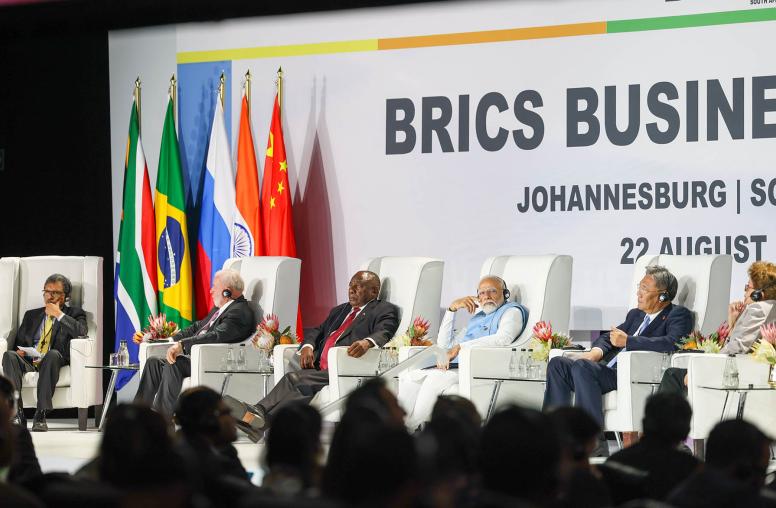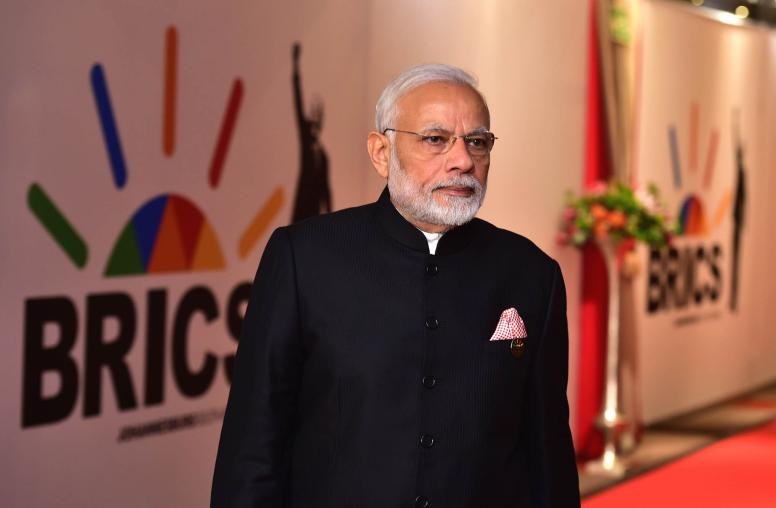The Limitations of India and Russia’s Transactional Relationship
Russia’s isolation, differing approach to multipolarity and closer ties with China make deeper India-Russia relations unlikely.
Since Russia’s unprovoked invasion of Ukraine in February 2022, it might seem as though ties between India and Russia have strengthened. While much of the West isolated Russia, India-Russia energy trade spiked, and India made efforts to accommodate Russia on the world stage. The two countries have also had visible public exchanges, such as a mid-January phone call between Indian Prime Minister Narendra Modi and Russian President Vladimir Putin and Indian External Affairs Minister S. Jaishankar’s trip to Moscow at the end of 2023.

Yet such public displays of bonhomie appear to have mostly enforced transactional trade ties and maintained previous deals, with few new strategic outcomes for the relationship. In the year ahead, how India balances its relationship with Russia will continue to be shaped by Russia’s declining international standing and strengthening relationship with China, India’s growing ties with the United States, and Russia’s evolving role in the Indo-Pacific and Eurasia.
Keeping Indian Interests on Top
One of the most notable aspects of the India-Russia relationship after the outbreak of the war in Ukraine was India’s unapologetic purchase of discounted Russian crude oil despite the questions it raised for the U.S.-India relationship.
The leap in crude oil trade helped the total trade between India and Russia reach nearly $50 billion from 2022-2023 — comfortably crossing the two countries’ previous aspiration of reaching $30 billion by 2025. India also exports a growing amount of food and pharmaceutical items to Russia, which are outside the ambit of Western sanctions. Meanwhile, Indian officials have not been shy about emphasizing that it is India’s refinement of Russian crude oil and the subsequent sale of it to other markets — including Europe — that has created some stability in the global oil market.
In a scenario where Russia remains more or less internationally isolated, this bilateral trade boom stands to increase even further as Russia’s economic ties with India will likely expand from traditional exports to automotive and electronic parts or renewables. And as India seeks to reinvent itself as a major manufacturing hub, a trading powerhouse and an influential services provider, it is likely to look to Russia as an important global market.
But on the other hand, India’s diversification efforts, coupled with long-standing self-reliance goals in defense manufacturing, are slowly bearing fruit. Indian private defense firms will supply equipment to the military worth approximately $7.2 billion over the 2024 and 2025 fiscal years according to a study by the Investment Information and Credit Rating Agency.
The Ukraine war has accelerated this trend, as Russia’s inability to supply equipment (such as the delay in supplying Russian-built frigates and S400 air defense system) has impacted India’s military modernization plans. Even with talks about joint production of defense equipment under the “Make in India” initiative reportedly in progress, the two sides have thus far failed to establish a mutually agreeable payment structure, adding to the challenges. New EU sanctions against Russia target at least one Indian company, introducing new complications for India-Russia trade.
Overall, deeper India-Russia cooperation in other areas of defense — including in nuclear issues — is a high possibility. But India’s diversification strategy may be a barrier for Moscow to draw real-time confidence from India as a defense partner.
Concurrently, India is also prioritizing co-production with technologically advanced “like-minded” states such as the United States, France, the European Union (EU), Israel and South Korea. Its recent cutting-edge technological defense cooperation efforts with the United States and semiconductor collaboration under the framework of EU-India Trade and Technology Council appear promising, with buy-in from each partner. This will not just help India create forward-looking Indo-Pacific mechanisms, but also give momentum to India’s high-tech-oriented manufacturing makeover.
In contrast, the Indian government is rethinking any major new strategic collaborations with Russia amid concerns that it will stall India’s growth and modernization due to current geopolitical constraints on Moscow. This reticence is reflected in India’s recent deals with Russia, including on the Kundankulam nuclear power project, which appear to be extensions of previous deals rather than new projects.
Notably, even India and Russia’s common connectivity project, the International North-South Transit Corridor (INSTC) — which also includes Iran and some Central Asian states, among others — is far from complete. The tensions in South Caucasus, the growing conflict in the Middle East and the Red Sea, and India’s enthusiasm for the India-Middle East-Europe Corridor offer additional reasons to question whether India will place serious emphasis on the INSTC or other connectivity initiatives that require cooperation with Russia.
India’s delicate downgrading of its relationship with Russia — which Moscow is so far acquiescing to — is further exemplified by India forgoing the once-annual prime minister-level summit with Russia while continuing to hold multiple foreign minister-level meetings. India seems to be staying firm to its narrative of “India First,” whether it is buying Russian oil or positioning itself in the Indo-Pacific. But sooner or later, India’s strategic tilt to the West led by Prime Minister Modi’s personal diplomacy — be it with Europe or the United States — is likely to overwhelm the historical, steady relations with Russia.
Much Ado About Multipolar Narratives
On the surface, multilateral cooperation between India and Russia seems robust, especially as Russia plans to host the expanded BRICS summit next year. The two also continue to coordinate positions at the U.N. and the Shanghai Cooperation Organization (SCO).
However, a closer analysis suggests that effective cooperation in multipolar spaces is limited. This has less to do with India’s emerging partnership with the United States and more with India’s rising rivalry with China.
Beijing is a consistent limitation on effective cooperation between Moscow and New Delhi in multilateral forums. Russia and India are engaged in multiple non-Western trilateral and multilateral forums, including the Asian Infrastructure Investment Bank, and the Russia-India-China trilateral (RIC). Of these, the RIC has become effectively moribund, particularly since the 2020 border standoff and Galwan clashes between India and China. Russia today simply lacks the capacity to balance the two Asian rivals amid its own growing challenges, including losing strategic influence in its backyard, be it in Central Asia or the South Caucasus.
While the SCO and BRICS have each considered recent expansions, the complexity and fragility of inter-state relations among members, the forums’ limited achievements, and China’s asymmetric dominance have posed problems for both India and Russia. In the SCO, where China’s financial clout over Central Asian states holds sway, Russia’s protracted war in Ukraine has already cost it its traditional influence. India is looking to make bilateral gains in Eurasia, but it cannot match China’s expansive and Belt and Road Initiative-led footprint. Even Russia and India’s combined capabilities are not enough to offset China’s influence in these multilateral forums, at least under the present scenario.
Furthermore — as the recent attacks by Iran against fellow SCO member Pakistan and Argentina’s refusal to join BRICS indicate — forums comprised of largely autocratic, often fickle countries will find it increasingly difficult to bond over larger economic, developmental or technological aims despite the bombastic intent of creating the so-called “post-Western” order.
Within this context, Russia and India’s convergence on multipolarity seems little more than empty rhetoric, their disparate visions for such multipolarity notwithstanding.
For Russia, promoting a multipolar, Eurasia-led world politics against the U.S.-led global order is definitively an anti-West foreign policy goal that would prioritize stable partnerships with both China and India.
India’s vision, in contrast, certainly sees a multipolar Asia as a fight against Western dominance in global institutions — but, importantly, it does not seek to exclude the West entirely, nor does it tap into the China-and-Russia-led anti-West narratives. However, India is known to not hesitate in using anti-West imagery in international financial institutions, particularly if its majoritarian shift or its strategic neutrality is questioned by the West.
Rising Stakes: Russia-China vs. India-U.S. Congruence
For India, its time-tested relationship with Russia has a strong basis in the Cold-War era, particularly in the public eye, where a large portion of Indians view Russia and Putin favorably. In addition to public attitudes, India’s policy approach, which centers around multi-alignment and its Asian-led multipolar vision, prioritizes Russia to maintain the balance vis-à-vis China.
However, India is wary of the emerging partnership between China and Russia and expects Moscow to keep its options open while dealing with China, which is what matters to India. Meanwhile, Russia’s growing hostilities with the West; its increasing economic and security cooperation with China; and its declining clout in mediating India-China disputes have lessened India’s ambitions and interests in the relationship. India has simultaneously reinvigorated its ties with the West both bilaterally and through minilateral mechanisms like the Quad.
Two years since the start of the war in Ukraine, India is still unlikely to play ball in the West’s attempts to isolate Russia. However, stability in the Indo-Pacific is a core foreign policy driver for a politically and technologically ambitious India — a desire that is likely to push it toward a closer embrace of the West. As a result, the transactional ties with Russia will have its limitations and will not affect India’s growing ties with the United States.
Therefore, since Russia’s invasion of Ukraine in 2022, there has been a decided — although not always immediately apparent — shift in the profile and trajectory of India-Russia relations. Regardless of their deep-rooted historical connections, India is increasingly prioritizing its own interests, which include a delicate balancing vis-à-vis Russia. While it continues to engage with Moscow on the economic, defense and multilateral fronts — as well as a potential counterbalance to China — New Delhi is now more cautious in its approach toward Russia. The degree and speed of India’s shift away from Russia is indeterminate. Moving forward, Russia will be less central in Indian foreign policy, with the primary focus instead being strategic maintenance rather than elevating relations.
Dr. Jagannath Panda is the head of the Stockholm Center for South Asian and Indo-Pacific Affairs at the Institute for Security and Development Policy in Sweden and a senior fellow at The Hague Centre for Strategic Studies in The Netherlands.



